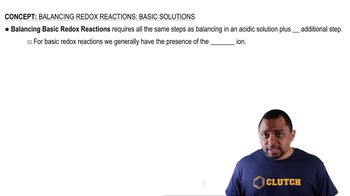Here are the essential concepts you must grasp in order to answer the question correctly.
Net Ionic Equations
Net ionic equations represent the actual chemical species that participate in a reaction, excluding spectator ions. They are derived from complete ionic equations by removing ions that do not change during the reaction. This simplification helps to focus on the essential components and the changes occurring in the reaction.
Recommended video:
Basic Solution
A basic solution has a pH greater than 7 and contains hydroxide ions (OH-). In such solutions, reactions may involve the addition of hydroxide ions to neutralize acids or to facilitate the formation of precipitates. Understanding the behavior of species in basic conditions is crucial for accurately writing net ionic equations.
Recommended video:
Balancing Basic Redox Reactions
Balancing Chemical Equations
Balancing chemical equations ensures that the number of atoms for each element is the same on both sides of the equation, adhering to the law of conservation of mass. This process often involves adjusting coefficients and may require accounting for charges in ionic reactions, especially in net ionic equations where charge balance is critical.
Recommended video:
Balancing Chemical Equations

 Verified step by step guidance
Verified step by step guidance


